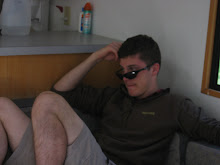 A statue of who-knows; the point of this picture is that we arrived in Kiev too early in the morning
A statue of who-knows; the point of this picture is that we arrived in Kiev too early in the morning This is Mikhail Bulgakov's apartment in Kiev, where he grew up and where he worked as a doctor for the White Army during the Russian Revolution. It was nice to contrast this apartment with his communal flat in Moscow. This apartment was featured as a setting in many of his books, including Preobrazhensky's flat in Heart of a Dog and Master's apartment in Master and Margarita (that's the book that was on my dresser, Emmy).
This is Mikhail Bulgakov's apartment in Kiev, where he grew up and where he worked as a doctor for the White Army during the Russian Revolution. It was nice to contrast this apartment with his communal flat in Moscow. This apartment was featured as a setting in many of his books, including Preobrazhensky's flat in Heart of a Dog and Master's apartment in Master and Margarita (that's the book that was on my dresser, Emmy).This is a video from the top of an undeveloped hill in the middle of Old Kiev. Kiev, like most Central and Eastern European places, has a significant pagan history. This hill is a place where witches traditionally come to cast spells on the city. You can see why from the view! The next day, we thought we spotted a witch casting a spell because of the way the woman was waving her arms, but maybe that wasn't the case. Anyways, it might be significant that the iron stairs leading up to this hill from the street (Andreivskii Spusk) sit almost directly across from Bulgakov's apartment, since Bulgakov is notorious for writing about the occult.
 This is some awesome graffiti I saw one day; it reminded me of my buddy Nathan Hill, who likes robots
This is some awesome graffiti I saw one day; it reminded me of my buddy Nathan Hill, who likes robots The graffiti is on the back wall of a playground
The graffiti is on the back wall of a playground This is the original bell tower of the Kiev Lavra (Monastery of the Caves). The Lavra is home to a functioning community of Orthodox monks and is also a UNESCO World Heritage Site, which causes some friction when the monks want to build something in their monastery. Under the monastery buildings are networks of caves that house holy relics and icons. That is usually the main attraction, but I did not take pictures in the cave networks.
This is the original bell tower of the Kiev Lavra (Monastery of the Caves). The Lavra is home to a functioning community of Orthodox monks and is also a UNESCO World Heritage Site, which causes some friction when the monks want to build something in their monastery. Under the monastery buildings are networks of caves that house holy relics and icons. That is usually the main attraction, but I did not take pictures in the cave networks. This is the view from inside the monastery: to the left is the Dnieper river, in the center is the extended campus of the monastery where the monks actually live, and to the right is a monstrous (i.e. big and ugly) metal statue memorializing Soviet victory in World War II
This is the view from inside the monastery: to the left is the Dnieper river, in the center is the extended campus of the monastery where the monks actually live, and to the right is a monstrous (i.e. big and ugly) metal statue memorializing Soviet victory in World War II One of the four planned Soviet buildings in Old Kiev, which currently serves as the Ukrainian Ministry of Foreign Affairs. Some of the Orthodox churches in Kiev were destroyed and it was planned to build four buildings like this one to replace the churches.
One of the four planned Soviet buildings in Old Kiev, which currently serves as the Ukrainian Ministry of Foreign Affairs. Some of the Orthodox churches in Kiev were destroyed and it was planned to build four buildings like this one to replace the churches. Our group visited Kiev at the same time as President Bush. As you can see, the Communist pensioners turned out en masse to protest his visit and NATO's proposed inclusion of Ukraine.
Our group visited Kiev at the same time as President Bush. As you can see, the Communist pensioners turned out en masse to protest his visit and NATO's proposed inclusion of Ukraine. This is St. Michael's, which was only recently completely reconstructed from the ground up. The original was a victim of Soviet remodeling.
This is St. Michael's, which was only recently completely reconstructed from the ground up. The original was a victim of Soviet remodeling.

























 This is the view of Toompea castle (
This is the view of Toompea castle (











 The pulpit inside the Dome Cathedral, which belongs to the Latvian Lutheran Church
The pulpit inside the Dome Cathedral, which belongs to the Latvian Lutheran Church























